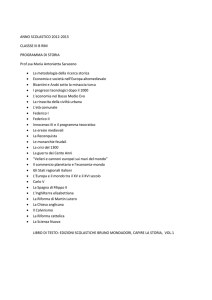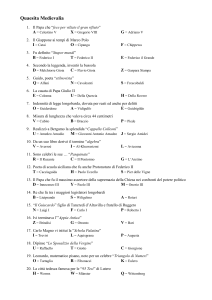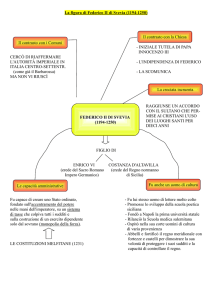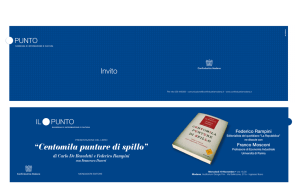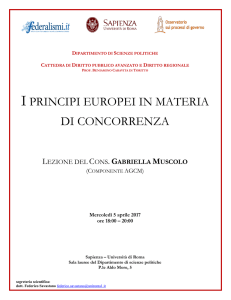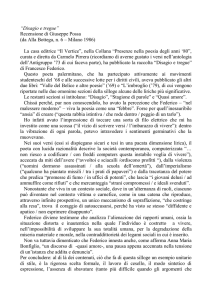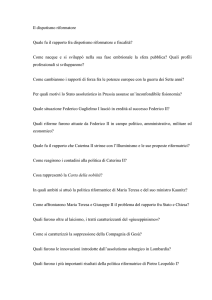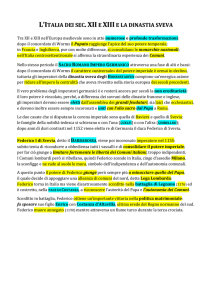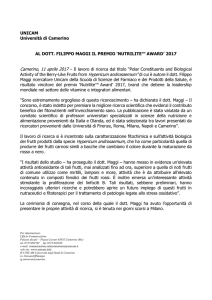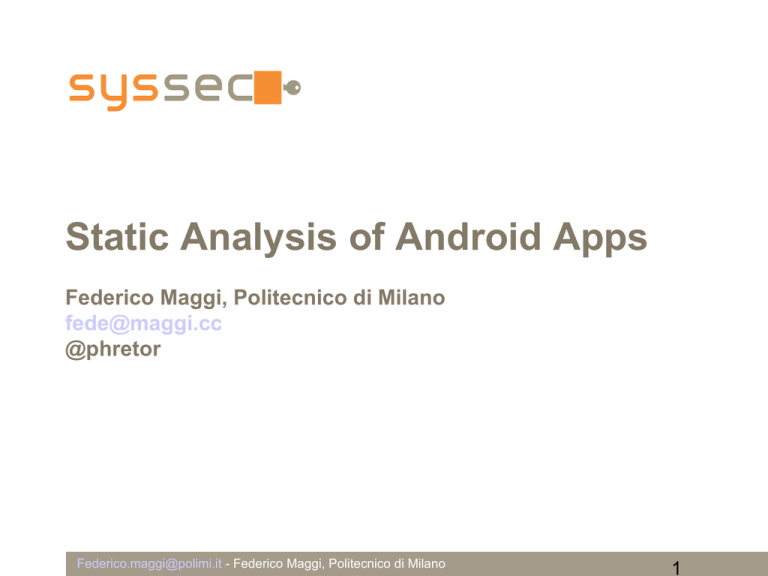
Static Analysis of Android Apps
Federico Maggi, Politecnico di Milano
[email protected]
@phretor
[email protected] - Federico Maggi, Politecnico di Milano
1
Outline
Dalvik overview
Dalvik executable file format
Dalvik machine
Disassembling
Decompiling
Real-world examples
Limitations
[email protected] - Federico Maggi, Politecnico di Milano
2
Dalvik Overview
- high-level language: Java
- translated in Dalvik bytecode
- different from Java bytecode
- register based (DEX)
- stack based (class)
- optimization
- space
- less instructions
- each instruction carries a lot of semantic
[email protected] - Federico Maggi, Politecnico di Milano
3
Toolchain
ca fe ba be 00 00 00 33 ...
Java Source
Code
javac
.java
class Toy1
static
static
static
{
int a;
int b;
int c;
public static void
hello() {
a = 0;
}
…
public static void main
(String[] args) {
hello();
world();
sum(a, b);
System.out.println(c);
}
}
Java Byte
Code
64 65 78 0a 30 33 35 00 ...
Dalvik Byte
Code
dx
.class
class Toy1 {
static int a;
.dex
.class Toy1
.super java/lang/Object
.source Toy1.java
static int b;
static int c;
Toy1();
Code:
0: aload_0 1: invokespecial #1 // Method java/lang/Object."<init>":
()V
4: return // Field c:I
21: invokevirtual #9 // Method java/io/PrintStream.println:
(I)V
24: return }
[email protected] - Federico Maggi, Politecnico di Milano
.field static a I
.field static b I
.field static c I
...
.line 19
invoke­static {},Toy1/hello ; hello()V
; nop .line 20
invoke­static {},Toy1/world ; world()V
; nop .line 21
4
[email protected] - Federico Maggi, Politecnico di Milano
5
Java Bytecode Format
Toy1.class
Toy1.java
javac
Heterogeneous
constant pool
- reference to methods
- string definitions
- constant definitions
Toy1
class definition
- class access flags
- class members
Other data
[email protected] - Federico Maggi, Politecnico di Milano
- additional support data
6
Disassembling Java Bytecode
ca fe ba be 00 00 00 33 ...
Java Source
Code
javac
.java
SourceFile: "Toy1.java"
minor version: 0
major version: 51
flags: ACC_SUPER
Constant pool:
#1 = Methodref
#11.#28
// java/lang/Object."<init>":()V
#2 = Fieldref
#10.#29
// Toy1.a:I
#3 = Fieldref
#10.#30
// Toy1.b:I
#4 = Fieldref
#10.#31
// Toy1.c:I
#5 = Methodref
#10.#32
// Toy1.hello:()V
#6 = Methodref
#10.#33
// Toy1.world:()V
#7 = Methodref
#10.#34
// Toy1.sum:(II)V
#8 = Fieldref
#35.#36
// java/lang/System.out:Ljava/io/PrintStream;
#9 = Methodref
#37.#38
// java/io/PrintStream.println:(I)V
#10 = Class
#39
// Toy1
#11 = Class
#40
// java/lang/Object
parser
[email protected] - Federico Maggi, Politecnico di Milano
Java Byte
Code
.class
javap
JVM
assembly
7
[email protected] - Federico Maggi, Politecnico di Milano
8
[email protected] - Federico Maggi, Politecnico di Milano
9
Java Bytecode to Dalvik Bytecode
Magic number: 64 65 78 0a 30 33 35 00
Toy1.dex
Toy1.class
Constant pool
- reference to methods
- string definitions
- constant definitions
Toy1
class definition
- class access flags
- class members
dx
Other data
[email protected] - Federico Maggi, Politecnico di Milano
- additional support data
10
Demo (Toy1.java)
- Execute Dalvik code in the emulator
[email protected] - Federico Maggi, Politecnico di Milano
11
JAR File Format
classes.jar
Toy1.class
javac
Toy1.class
Heterogeneous
constant pool
Toy1
class definition
Toy1.class
jar
Toy2.class
javac
Toy2.class
Other data
Toy2.class
Heterogeneous
constant pool
Toy2
class definition
Other data
[email protected] - Federico Maggi, Politecnico di Milano
12
Sharing is Caring (for space)
classes.jar
Toy1.class
Heterogeneous
constant pool
Toy1
class definition
- shared constant pool
- normalized definition
- overall space saving
Other data
Toy2.class
Heterogeneous
constant pool
Toy2
class definition
classes.dex
Constant pool
Toy1.class
Toy1
class definition
Toy2.class
Toy2
class definition
Other data
Other data
[email protected] - Federico Maggi, Politecnico di Milano
13
Disassembling Dalvik Bytecode
ca fe ba be 00 00 00 33 ...
Java Source
Code
.java
Opened 'Toy1.dex', DEX version '035'
DEX file header:
magic : 'dex\n035\0'
checksum : d2b96c58
signature : b3f3...aeb0
file_size : 980
header_size : 112
link_size : 0
link_off : 0 (0x000000)
string_ids_size : 21
string_ids_off : 112 (0x000070)
type_ids_size : 7
type_ids_off : 196 (0x0000c4)
proto_ids_size : 4
proto_ids_off : 224 (0x0000e0)
field_ids_size : 4
field_ids_off : 272 (0x000110)
method_ids_size : 7
method_ids_off : 304 (0x000130)
class_defs_size : 1
class_defs_off : 360 (0x000168)
data_size : 588
data_off : 392 (0x000188)
javac
Java Byte
Code
64 65 78 0a 30 33 35 00 ...
dx
.class
Dalvik Byte
Code
.dex
DEX
assembly
dexdump
parser
[email protected] - Federico Maggi, Politecnico di Milano
14
header
classes.dex
Constant pool
Toy1.class
Toy1
class definition
Toy2.class
Toy2
class definition
Other data
[email protected] - Federico Maggi, Politecnico di Milano
15
class_def
constructor
code
[email protected] - Federico Maggi, Politecnico di Milano
17
Method Definition
method member
method ID
method name
take two ints and return void
registers used: v0 v1 v2
2nd parameter
other (e.g., local vars)
[email protected] - Federico Maggi, Politecnico di Milano
1st parameter
18
Types
- reference types
- objects Lpackage/name/ObjectName
- arrays [I → int[], [[I → int[][], [Ljava/lang/String, ...
- primitive types (all the rest)
- C: char
- V: void
- Z: boolean
- B: byte
- S: short
- I: int
- J long (64 bits)
- F: float
- D: double (64 bits)
[email protected] - Federico Maggi, Politecnico di Milano
19
Code
v0 ← v1 + v2
Sum the content of register v1
and v2, and move result in v0
- 218 op-codes
Put content of v0 in static field
- long instructions
- best reference: http://tinyurl.com/dalvik-opcodes
[email protected] - Federico Maggi, Politecnico di Milano
20
Dalvik Machine
- register based (JVM is stack based)
- 2^64 registers (wow!)
- 32 bits registers
- how about long/double? Just use two registers
[email protected] - Federico Maggi, Politecnico di Milano
21
Stack Based: JVM
registers
int s = 3 + 4;
R0
R1
R2
R3
R4
stack
iconst_3
iconst_4
iadd
istore_0
[email protected] - Federico Maggi, Politecnico di Milano
22
Stack Based: JVM
registers
int s = 3 + 4;
R0
R1
R2
R3
R4
stack
iconst_3
iconst_4
iadd
istore_0
3
[email protected] - Federico Maggi, Politecnico di Milano
23
Stack Based: JVM
registers
int s = 3 + 4;
R0
R1
R2
R3
R4
stack
iconst_3
iconst_4
iadd
istore_0
4
3
[email protected] - Federico Maggi, Politecnico di Milano
24
Stack Based: JVM
registers
int s = 3 + 4;
R0
R1
R2
R3
R4
stack
iconst_3
iconst_4
iadd
istore_0
4
3
[email protected] - Federico Maggi, Politecnico di Milano
7
25
Stack Based: JVM
registers
int s = 3 + 4;
R0
R1
R2
R3
R4
7
stack
iconst_3
iconst_4
iadd
istore_0
7
[email protected] - Federico Maggi, Politecnico di Milano
26
Register Based: Dalvik
registers
int s = 3 + 4;
R0
R1
R2
R3
R4
stack
const/4 r0 3
add­int/lit8 r1 r0 4
[email protected] - Federico Maggi, Politecnico di Milano
27
Register Based: Dalvik
registers
int s = 3 + 4;
R0
R1
R2
R3
R4
3
stack
const/4 r0 3
add­int/lit8 r1 r0 4
[email protected] - Federico Maggi, Politecnico di Milano
28
Register Based: Dalvik
registers
int s = 3 + 4;
R0
R1
3
R2
R3
R4
3+4
stack
const/4 r0 3
add­int/lit8 r1 r0 4
[email protected] - Federico Maggi, Politecnico di Milano
29
Register Based: Dalvik
registers
int s = 3 + 4;
R0
R1
3
R2
R3
R4
3+4
stack
const/4 r0 3
add­int/lit8 r1 r0 4
[email protected] - Federico Maggi, Politecnico di Milano
30
Disassembling: The smali language
- dexdump's output is rather verbose
- the smali language is an alternative and more
readable intermediate language
- the concepts seen so far are the same
[email protected] - Federico Maggi, Politecnico di Milano
31
smali/baksmali Example
[email protected] - Federico Maggi, Politecnico di Milano
32
smali/baksmali Example
[email protected] - Federico Maggi, Politecnico di Milano
33
smali/baksmali Example
[email protected] - Federico Maggi, Politecnico di Milano
34
Simple Patching From smali Code
- goal: bypass password protection
–
–
–
let's suppose that the password is dynamic
so we can't just change/read it
we must modify the control flow
- edit the assembly code
- re-assemble it with smali *.class
- you will try this later ;-)
[email protected] - Federico Maggi, Politecnico di Milano
35
Decompiling
- from intermediate language to source code
- most of the times, decompiling is feasible
ca fe ba be 00 00 00 33 ...
Java Source
Code
javac
.java
~.java
Java Byte
Code
64 65 78 0a 30 33 35 00 ...
dx
.class
Luyten
.jar
[email protected] - Federico Maggi, Politecnico di Milano
Dalvik Byte
Code
.dex
dex2jar
36
[email protected] - Federico Maggi, Politecnico di Milano
37
[email protected] - Federico Maggi, Politecnico di Milano
38
Patching from Source Code
- it is possible, of course
- the decompilation process leaves
“something” behind (e.g., var names,
constants)
- libraries need to be re-imported and re-linked
- Eclipse will help you in this, but it's tedious
- just create a project and make sure that you
solve all the warnings and errors you'll be
fine
[email protected] - Federico Maggi, Politecnico di Milano
39
In practice
- recompiling from source is usually a lot of
manual work
- best approach
- decompile to source
- decode the APK with apktool d Old.apk
- figure out what the app does by looking at *.java
- patch the *.smali
- reassemble with apktool b Old/ New.apk
[email protected] - Federico Maggi, Politecnico di Milano
40
Limitations
- static analysis can be hindered by
obfuscation
- sometimes even disassembling is difficult
- disassembling as well as decompiling strive
to solve ambiguities
- sometimes such ambiguities can be
introduced manually by the malicious guys
[email protected] - Federico Maggi, Politecnico di Milano
41
Summary
- what is JVM code and how does it look like
- what is Dalvik code and how it differs from
JVM
- how to disassemble using dexdump and
baksmali
- how to patch and re-assemble using smali
- how to decompile using dex2jar and Luyten
- how to recompile using a Java compiler
- Thanasis will tell you more about Dalvik ;-)
[email protected] - Federico Maggi, Politecnico di Milano
42
Practical Session: Part 1
- PlayMe.mp3 is just landed to your laptop, but
you suspect it's not an mp3, maybe you want
to use “file” or “hexdump” to take a look at its
first bytes and see if you find something
familiar
- Done already? Why don't you take a look at
SecondApp.apk or Toy3.dex and see if you
can do something there to p0wn them!
[email protected] - Federico Maggi, Politecnico di Milano
43
Practical Session: Part 2
- You just found out that your device has a
suspicious SecondApp.apk file which seem
to be coming out from nowhere...you better
not execute it! It's maybe safer to take a look
at its code.
- Done already? Why don't you take a look at
Main.apk? Seems a nice battery-saving app.
Not entirely sure though...
[email protected] - Federico Maggi, Politecnico di Milano
44
Practical Session: Part 3
Warning, warning! Looks like you received an
application that looks malicious. You better
fire up your favorite disassembler and
decompiler and dig into the code before it's
too late!
[email protected] - Federico Maggi, Politecnico di Milano
45

